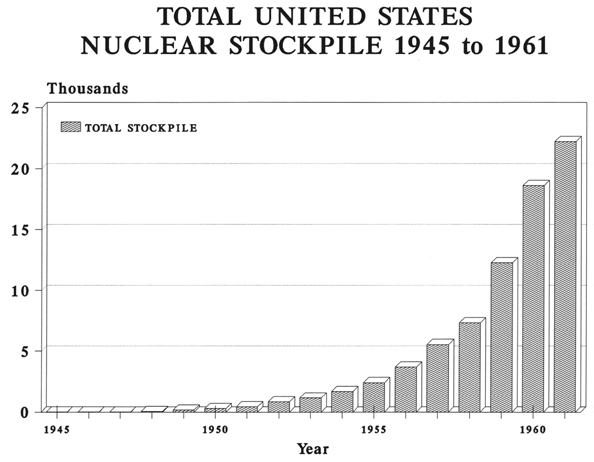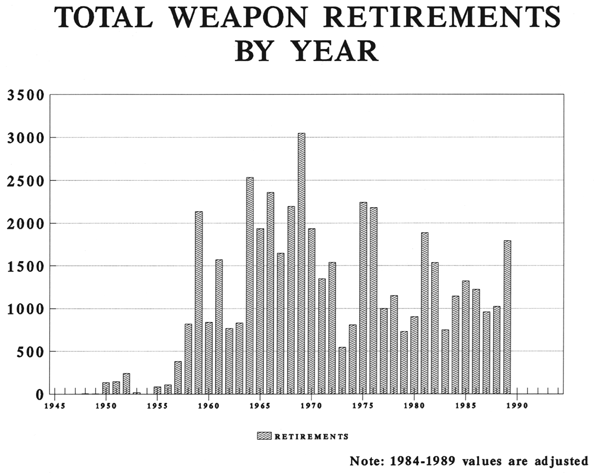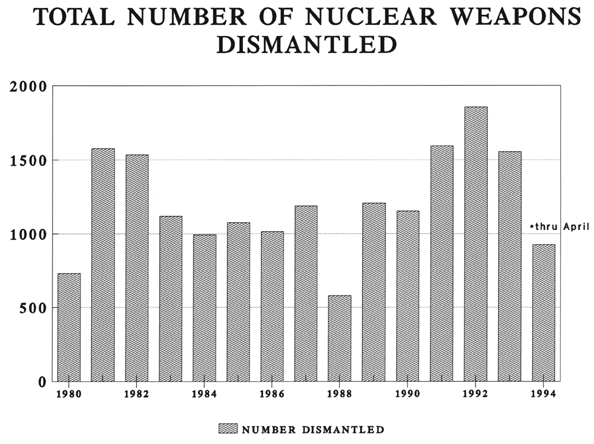

DECLASSIFICATION
OF CERTAIN CHARACTERISTICS
OF THE UNITED STATES NUCLEAR WEAPON
STOCKPILE
The Department of Energy and the Department of Defense have jointly declassified certain characteristics of the Nation's nuclear weapon stockpile.
SPECIFICALLY:
The Department of Energy and the Department of Defense have jointly declassified the total megatonnage of the nuclear weapon stockpile for the years 1945 to the present.
The Department of Energy and the Department of Defense have jointly declassified the total number of nuclear weapons in the stockpile for the years 1949 to 1961.
The Department of Energy and the Department of Defense have jointly declassified the total number of weapon builds by year for weapon systems fully retired.
The Department of Energy and the Department of Defense have jointly declassified the total number of weapon retirements for the years 1945 to 1989. Disassembly of weapons for disposal from 1980 to the present is also provided.
See attached charts for detailed descriptions of the declassified stockpile characteristics.
BACKGROUND:
The size of the stockpile has changed dramatically over the past 50 years. In recent years, a large number of weapons have been retired in response to treaty obligations and unilateral commitments.
After reaching peak megatonnage around 1960, total megatonnage in the stockpile has decreased to about 10 percent of the peak.
The quantities listed here are based on the evaluation of the records available. The quantities may be updated or revised in the future after re-evaluation of the methodology used originally.
Retirement numbers provided here reflect weapons retired for conversions, modifications, or disassembles for disposal. Retirement numbers depend critically on how the term "retirement" is defined.
Disassembly for disposal reflect weapons actually dismantled without including the number of weapons dismantled to change out a component within the weapon or dismantled and rebuilt for quality assurance reliability testing.
BENEFITS:
As part of the Secretary of Energy's Openness Initiative, the Department of Energy and the Department of Defense are declassifying information regarding characteristics of the United States nuclear weapon stockpile. As a result of this declassification, the American public will have information that is important to the current debate over the nuclear arsenal. The information released will help provide a historical perspective of how the stockpile has changed over the past 50 years. It should encourage other nations to declassify similar nuclear weapon stockpile information.
With the U.S. release of this information, it is hoped that other nuclear weapon states will be encouraged to release similar information. The release of retirement rates up to 1989 will show nonnuclear weapon states that the United States has acted responsibly by retiring and dismantling weapons it no longer requires.
WHO ARE THE KEY STAKEHOLDERS?
The Public. The public will have a better understanding of the nature of the Nation's nuclear deterrent.
Freedom of Information Act Requesters. This information has been long sought by certain public interest groups through Freedom of Information Act requests.
Public Interest Organizations. Stakeholders include environmental, safety and health groups, historians, archivists, researchers, scientists, and industrial workers, as well as State and Federal personnel. With this declassification, those interested in oversight of nuclear weapons related activities will have additional information regarding the U.S. nuclear weapon stockpile. Public interest organizations which have expressed such an interest include (but are not limited to): Energy Research Foundation, Environmental Information Network, Friends of the Earth, Greenpeace, League of Women Voters, Livermore Conversion Project, Military Production Network, National Security Archive, Natural Resources Defense Council, Nevada Desert Experience, Physicians for Social Responsibility, Plutonium Challenge, and the Sierra Club.
Arms Control Negotiators. Negotiators for the United States can use this information to seek similar information from other nuclear weapon states.
U.S.
Department of Energy
Office of Public Affairs
Contact: Sam
Grizzle
(202) 586-5806
- - - - - - - - - - - - - - - - - - - - - - - - - - - - - - - - - - - - - - - - - - - - - - - - - - - - - - - - - -
Declassified Stockpile Data 1945 to 1994
Total quantities cover years 1945 to 1961. Total quantities 1945-1948 were already unclassified. Total quantities of the stockpile after 1961 remain classified since there were weapon systems introduced in 1962 and later that are still in the current stockpile.
Builds numbers reported below are total annual quantities for fully retired weapon systems. This represents a subset of United States nuclear weapon production. The annual production of nuclear weapons still in the stockpile remain classified.
Retirement rates from 1984 to 1989 are adjusted from the stockpile memorandum retirement numbers to better reflect the number of weapons truly retired. Retirement numbers reported below reflect weapons retired for conversions, modifications, or disassemblies for disposal. Retirement numbers depend critically on how the term retirement is defined.
Disassemblies reported below reflect only the number of weapons dismantled for actual disposal. It should be noted that raw disassembly numbers published elsewhere by the Department are typically larger reflecting the number of times a weapon is disassembled but not necessarily disassembled for disposal or dismantlement purposes. An example of this would be for repair, a weapon might be disassembled to replace a part and then returned to the stockpile. Records prior to 1980 on disassemblies for disposal are not immediately available but will be provided in the future if possible.
|
YEAR |
TOTAL |
MEGATONNAGE |
BUILDS |
RETIREMENTS |
DISASSEMBLIES |
|
1945 |
2 |
0.04 |
2 |
0 |
0 |
|
1946 |
9 |
0.18 |
7 |
0 |
0 |
|
1947 |
13 |
0.26 |
4 |
0 |
0 |
|
1948 |
50 |
1.25 |
43 |
6 |
0 |
|
1949 |
170 |
4.19 |
123 |
3 |
0 |
|
1950 |
299 |
9.53 |
264 |
135 |
0 |
|
1951 |
438 |
35.25 |
284 |
145 |
0 |
|
1952 |
841 |
49. 95 |
644 |
241 |
0 |
|
1953 |
1,169 |
72.80 |
345 |
17 |
0 |
|
1954 |
1,703 |
339.01 |
535 |
1 |
0 |
|
1955 |
2,422 |
2,879.99 |
806 |
87 |
0 |
|
1956 |
3,692 |
9,188.65 |
1,379 |
109 |
0 |
|
1957 |
5,543 |
17,545.86 |
2,232 |
381 |
0 |
|
1958 |
7,345 |
17,303.54 |
2,619 |
817 |
0 |
|
1959 |
12,298 |
19,054.62 |
7,088 |
2,135 |
0 |
|
1960 |
18,638 |
20,491.17 |
7,178 |
838 |
0 |
|
1961 |
22,229 |
10,947.71 |
5,162 |
1,571 |
0 |
|
1962 |
CLASSIFIED |
12,825.02 |
4,529 |
766 |
0 |
|
1963 |
CLASSIFIED |
15,977.17 |
3,185 |
830 |
0 |
|
1964 |
CLASSIFIED |
16,943.97 |
3,493 |
2,534 |
0 |
|
1965 |
CLASSIFIED |
15,152.50 |
3,519 |
1,936 |
0 |
|
1966 |
CLASSIFIED |
14,037.46 |
2,429 |
2,357 |
0 |
|
1967 |
CLASSIFIED |
12,786.17 |
1,693 |
1,649 |
0 |
|
1968 |
CLASSIFIED |
11,837.65 |
536 |
2,194 |
0 |
|
1969 |
CLASSIFIED |
11,714.44 |
684 |
3,045 |
0 |
|
1970 |
CLASSIFIED |
9,695.20 |
219 |
1,936 |
0 |
|
1971 |
CLASSIFIED |
8,584.40 |
1,073 |
1,347 |
0 |
|
1972 |
CLASSIFIED |
8,531.51 |
1,546 |
1,541 |
0 |
|
1973 |
CLASSIFIED |
8,452.00 |
1,171 |
544 |
0 |
|
1974 |
CLASSIFIED |
8,325.22 |
959 |
807 |
0 |
|
1975 |
CLASSIFIED |
7,368.38 |
748 |
2,240 |
0 |
|
1976 |
CLASSIFIED |
5,935.51 |
427 |
2,181 |
0 |
|
1977 |
CLASSIFIED |
5,845.0 |
221 |
998 |
0 |
|
1978 |
CLASSIFIED |
5,721.16 |
50 |
1,148 |
0 |
|
1979 |
CLASSIFIED |
5,696.34 |
170 |
730 |
0 |
|
1980 |
CLASSIFIED |
5,618.86 |
0 |
904 |
732 |
|
1981 |
CLASSIFIED |
5,382.91 |
30 |
1,887 |
1,577 |
|
1982 |
CLASSIFIED |
5,358.89 |
338 |
1,537 |
1,535 |
|
1983 |
CLASSIFIED |
5,232.47 |
217 |
749 |
1,120 |
|
1984 |
CLASSIFIED |
5,192.20 |
187 |
1,143 |
994 |
|
1985 |
CLASSIFIED |
5,217.48 |
195 |
1,322 |
1,075 |
|
1986 |
CLASSIFIED |
5,414.54 |
140 |
1,224 |
1,015 |
|
1987 |
CLASSIFIED |
4,882.14 |
0 |
958 |
1,189 |
|
1988 |
CLASSIFIED |
4,789.77 |
0 |
1,023 |
581 |
|
1989 |
CLASSIFIED |
4,743.34 |
0 |
1,794 |
1,208 |
|
1990 |
CLASSIFIED |
4,518.91 |
0 |
0 |
1,154 |
|
1991 |
CLASSIFIED |
3,795.94 |
0 |
0 |
1,595 |
|
1992 |
CLASSIFIED |
3,167.88 |
0 |
0 |
1,856 |
|
1993 |
CLASSIFIED |
2,647.31 |
0 |
0 |
1,556 |
|
1994 |
CLASSIFIED |
2,375.30 |
0 |
0 |
926 as of April |
- - - - - - - - - - - - - - - - - - - - - - - - - - - - - - - - - - - - - - - - - - - - - - - - - - - - - - - - - -





- - - - - - - - - - - - - - - - - - - - - - - - - - - - - - - - - - - - - - - - - - - - - - - - - - - - - - - - - -
QUESTIONS AND ANSWERS
Q. Why wasn't this information declassified earlier?
A. The United States maintains the nuclear weapon stockpile as a deterrent. During the Cold War, most information concerning the stockpile was classified for clear reasons of national security. Upon review, it was determined that some general information concerning the stockpile can now be released without harm to national security.
Q. When will more detailed information on the nuclear stockpile be declassified?
A. The nuclear stockpile is extremely important to the defense of the Nation. At this time, release of more detailed information is not judged to be in the Nation's best interest.
Q. Why are total quantities provided only up to 1961?
A. Past total stockpile numbers which are composed, even partially, of weapon systems still in the stockpile remain classified. Further data on total stockpile numbers may be released in the future as additional weapon systems are retired.
Q. Why are retirement rates and disassembly for disposal rates different from each other from year to year?
A. Retirement is an accounting change that authorizes removal of a weapon from the nuclear stockpile and its transfer to the Department of Energy for conversions, modifications, or eventual disassembly. Disassembly for disposal is the process of taking apart a nuclear weapon. Disassembly rates depend on available capacity at Pantex.